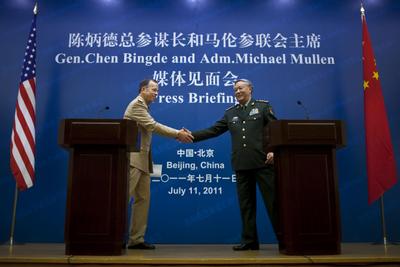This emerging dual leadership structure reflects new configurations related to the rise of China in the past three decades, as well as the continuity of US leadership in world affairs.
Over the past few decades, the centre of world economic activities has gradually shifted from the Atlantic to the Pacific. Following Japan’s example from the 1950s to the 1980s, China’s economy has grown at an unprecedented rate. In 2010, China’s GDP bypassed Japan’s to become the world’s second largest economy. In the economic and trade dimensions, many people pay more attention to what China has to say, and as such China has seen an enhancement in its decision-making role in international organisations such as the World Bank and IMF. For example, in March 2011, the IMF passed a resolution to increase the voting power of China within the IMF, making it the third-largest member country. China’s increased influence is most prevalent in the Asia Pacific because virtually all the surrounding economies have increased their dependence on China’s financial and trade markets.
In the military, security and political spheres, the US has undoubtedly maintained an absolute advantage. If we look at international organisations and institutions related to military and security in the Asia Pacific, most of them are under the control of the US. This includes US-led bilateral security institutions such as the US–Japan security alliance, and the US–South Korea military alliance. This also comprises of military partnerships between the US and Asian countries such as the Philippines, Australia, New Zealand, Thailand, India, Pakistan Singapore and Taiwan. The US has also developed close security ties with other regional powers, like Vietnam and Pakistan. The gap in political influence between the US and China is equally noticeable. This is not only because the US remains the only world superpower but also because Washington has typically paid close attention to soft power.
The US has the following four advantages in terms of its soft-power diplomacy: first, its ability to adjust its foreign policy to reflect a high moral stance; second, the influence of its news media to guide public opinion; third, its international credibility which strengthens and maintains alliance relationships; and, finally, its constant public debate over domestic and foreign policy, leading to a greater ability to self-correct and avoid policy errors.
The emergence of this dual leadership is regional. It is specific to the Asia Pacific and not necessarily dominant on the global stage. We should not think of it as the same as the G2 proposition — that global governance should be led by the US and China. This dual leadership is equally different from the Cold War-era zero-sum game. It is more conducive to conflict resolution. It sees the application of economic techniques, rather than military backlash or the exertion of political influence, to reach a win-win solution.
The emerging dual leadership position is the result of a natural development process. It reflects the reality and core national interests of China and the US and the responsibilities of the two great powers. A dual leadership structure implies that each power has its strengths and weaknesses. The two powers need to constantly adjust to, and support, one another. Each should be prepared to make compromises in their weaker areas, and to be more proactive and willing to assume a clear leadership role in their stronger areas. A ‘3-C’ principle will become necessary, namely coordination, cooperation and compromise between China and the US. The 3-C spirit concept argues that ‘the two countries need to find accommodating ways, such as mutual acknowledgment of each other’s core interests, that allow the two countries to exist as ‘stakeholders’.
Different perspectives from international relations can help us determine whether China’s rise will result in a zero-sum game or a win-win situation. On broad common and overlapping interests, such as regional stability and prosperity, the two powers should be able to handle their differences through peaceful means. To accomplish this, they should work to avoid conflict and further develop crisis prevention and management mechanisms. According to the win-win perspective, China’s rise could be good for both the US and China. Interdependency theory explains that as long as relations between major powers can be managed, conflict is not inevitable. It is important to keep this in mind as growing globalisation and regional integration results in greater economic interdependence between the US and China.
The dual leadership structure has proven positive so far, with benefits for both the US and China, but it remains to be seen whether the two powers can coordinate well with other powers in the region, such as Japan, Russia, ASEAN, the two Koreas and Australia. One possibility is that some regional mechanisms, such as the Six Party Talks, might be institutionalised so that all major players can be included.
This new leadership structure is likely to last for a long period — well into the rest of this century. China’s economic power may continue to grow and US military power may continue to be dominant, so one will not be able to replace the other in certain fields. The two countries and other players have many reasons to expect a complementary relationship. Not only will China and the US play a leading role in a certain field, but the dual-leadership structure may also ensure regional stability and prosperity for years to come.
Quansheng Zhao is Professor of International Relations and Director of the Center for Asian Studies at American University. This article is a digest of a lecture delivered at the Australian National University.

